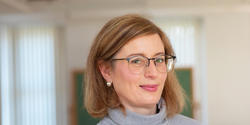A generous gift helps RISD bring art and design to bear on the future of the planet.
Designing with Living Systems

“My fascination with architecture started when I first observed living systems through a microscope,” says Assistant Professor Katia Zolotovsky. “The beauty of natural structures opened me up to finding my creative side, which eventually led to my interests in biodesign and the material computation encoded in DNA.”
Since joining the Experimental and Foundation Studies faculty last July, Zolotovsky has been sharing her passion for biodesign with RISD students in her Spatial Dynamics classes and beyond. “RISD students are so motivated, bright and creative,” she says, “and they’re eager to engage with questions of material culture and ecology.” She has authored or co-authored a number of articles on biodesign, including a recently published piece on morphometric design strategies, a chapter on guided growth strategies included in the book Active Matter edited by Skylar Tibbits and a study of metamesh published by ScienceDirect.

Zolotovsky is now working with students Avantika Velho 22 ID, Annie Chen BRDD 23 ID and Matthew Derry BRDD 22 ID to develop a curriculum for teaching digital fabrication using biomaterials made from food waste recovered by RISD Dining. The project was developed in a class taught by Industrial Design Professor Peter Yeadonand Nature Lab Interim Director Jennifer Bissonnette.“RISD students care deeply about sustainability and waste,” says Zolotovsky. “It’s not just something they’re studying; it’s part of their value system.”
Zolotovsky launched an informal (virtual) biodesign forum in which students can share ideas about everything from lab work to community-based design to biomorphic wearables. “We just had a really interesting session about hemp and culture,” she says.
“The beauty of natural structures opened me up to finding my creative side, which eventually led to my interests in biodesign and the material computation encoded in DNA.”
This spring she’s also teaching a section of Adaptive Ecologies: Biointeractive Surfaces, part of RISD’s ongoing research partnership with the Hyundai Motor Group. “The focus this year is once again on integrating living systems into our designs,” she says. “The research is focused on using a new kind of interactivity in products and surfaces, programmed by DNA and allowing biological functions of sensing, regenerating and pollution remediation for building healthy relationships with our environment.”

Two of the great things she’s discovering about RISD, Zolotovsky says, are the freedom faculty members have to shape their own courses and the opportunities for research. She’s currently working with Yeadon,Anastasiia Raina and the Nature Lab on the next iteration of the NSF-funded EPSCoR (Experimental Program to Stimulate Competitive Research) grant, a multiyear research collaboration between eight Rhode Island colleges and universities investigating the impact of coastal pollution on marine life and local communities.
“We’re meeting with scientists who work on coastal pollution and figuring out how our RISD team can play an active role in the research,” Zolotovsky explains. “Scientists often have a very defined scope, where they’re looking at one specific scientific question, but we intend to zoom out and create a strategy for sharing knowledge among all of the stakeholders involved.” The evolving proposal involves wearable devices that will allow fish and other organisms to collect and transmit coastal pollution data scientists can use to improve conditions.

Zolotovsky is also building a toolkit for spatial design with biomaterials as a sustainable alternative to plastic. Supported by a faculty research grant, she and research assistant Manini Banerjee 23 ID are creating a website that provides tutorials on how to use RISD’s laser cutters, 3D printers and soft matter extrusion systems to make scaffolds, molds and lattices from biomaterials. “The website will help students to go beyond the sheet material that is usually the starting point for working with bioplastics,” she adds.
Despite the fact that she joined the RISD faculty during a pandemic and hasn’t met many colleagues in person, Zolotovsky is delighted with the sense of community she has experienced thus far. “RISD’s kind of teaching leads to such interesting conversations and connections,” she says. “And those connections between students and professors are so important right now. We’re all learning from each other.”
—Simone Solondz / RISD photos by Jo Sittenfeld MFA 08 PH
April 12, 2021


